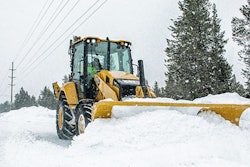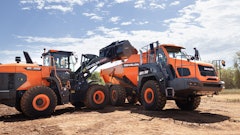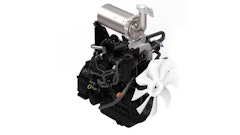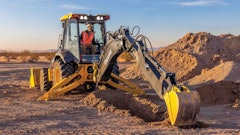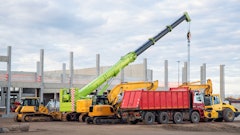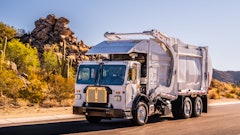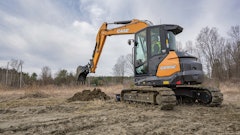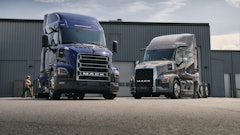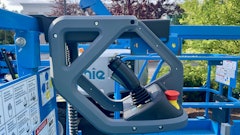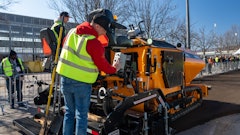You know, I think that when I look back at MINExpo 2021 in about 10 years, I’m going to remember that show in particular because of two really big product unveilings.
The first, we already covered. (If you haven’t seen our previous MINExpo coverage on the Cat R1700 XE, a battery-powered underground loader that can be charged in just 20 minutes, be sure to check that out.) But the second, equally important—and maybe even more disruptive—big announcement was in the Komatsu booth.
Well, it was there in spirit anyway.
Komatsu is calling the MC51—a machine more than 10 years in the making—a continuous mining machine, and it’s been designed to completely disrupt the traditional hard rock underground mining cycle. And there’s really three reasons Komatsu has created this machine: Consolidation, Control and Cost.
Consolidation because the MC51 allows you to do what traditionally involves three different processes and machines into just one machine. Control, because it operates nearly autonomously. And Cost, because the combination of consolidation and control with the lower power and ventilation demands associated with the MC51 due to the way this machine operates, all amount to greater efficiency in both power and production.
Consolidation
But let’s get into specifics. What exactly is it about this machine that allows it to replace machines like a Jumbo?
At a core level, the MC51 approaches removing hard rock in a fundamentally different way than traditional mining methods or even tunnel boring machines. Where as both of those techniques involve drilling—the Jumbo drills holes for dynamite to be placed in—the MC51 cuts the rock away through the use of a cutting head.
So, instead of using compression to break through rock face, the MC51 is based around removal with intention. Placing that drilling head where you don’t want rock to be and simply erasing it.
The machine does does this by spinning that cutting head at a high speed and then placing it against the rock face at a 45 degree angle. That allows the cutting head to get behind the layer of rock it needs to remove and then pull the material away from the face.
It really is a completely opposite way of removing material.
And not just from the drilling perspective, right? Dynamite removes rock through compression as well. The dynamite explodes from within the rock, creating a highly compressed force that then expands and takes the rock with it.
Control
The other byproduct of that type of rock removal is that you can’t easily control or predict the size of the debris. In many situations that can also lead to overbreak, and the extra cost of having to move rock that you didn’t necessarily have to remove in the first place.
Overbreak is essentially eliminated by the MC51 because the cutting head’s removal of the material is so controlled that not only does it produce consistent and much smaller shards of debris, it does so at the direction of a digital design plan.
In other words, this machine only removes the rock that you want it to. Nothing more, nothing less.
Though the cutting happens autonomously through loaded up plans, the machine is trammed into and out of position tele-remotely by an operator using a tethered control box.
And with the smaller size of the rock coming off the face coupled with less overall tonnage of rock to remove, the MC51 can even eliminate the mucking process typically performed by underground loaders.
Right through the middle of the machine, you can see a conveyor system running. That conveyor system is fed by two spinning fan-like blades that pull in piles of the debris.
The debris is then fed through the conveyor system and deposited. Komatsu says the conveyor system can be used in tandem with a loader which will tram the debris to a truck, but they are also working on an extender to the conveyor system that will transport the debris all the way through to the drift opening.
Cost
The MC51 is also a fully-electric machine—though it isn’t battery-powered. It requires a tethered connection to the grid, which Komatsu says shouldn’t be a problem as most underground hard rock operations have substantial electrical infrastructure at the face of the rock.
Komatsu says that it doesn’t require much power to operate either since the cutting head is more efficient than a machine that employs pulverization.
Plus, because the machine creates no heat and emits no diesel fumes—and it doesn’t require explosives—the MC51 cuts an outfit’s costs by requiring less ventilation.
Conclusion
Komatsu has designed the MC51 for 5x5 meter drifts—the most common size of development tunnel seen today. The company has partnered with mining giant Vale to test two prototype machines.
However, there are some caveats. Drifts that are smaller than 5x5 obviously won’t be able to make use of this machine. And while the expanded conveyor system sounds awesome. It’s most likely that you won’t be replacing your underground loader anytime soon. After all, it sounds like you’ll still need a loader at some point in the process.
Another machine the MC51 can’t replace is a hard rock bolter. Once the material has been removed, you’ll still need to tram the MC51 out of the way for a bolter like Komatsu’s new ZB21.
Like we said at the top of the video, the MC51 is a potentially very disruptive machine. And though Komatsu has been at the development of the machine for more than a decade, it’s not quite ready.
Komatsu isn’t commenting on potential release dates for the machine, noting only that machines of this type, serving the customers it will serve, require thorough validation. Something they are confident their partnership with Vale will provide.







